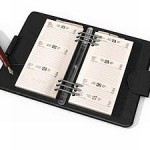
Defining Meeting Agenda
Meeting Agenda is an event planning document that includes an ordered sequence of issues to be raised and discussed during a meeting. It also represents an underlying list of tasks or actions to be done by assigned individuals before, during or after the meeting. It is a way to control information interchange between the participants and to direct the course of the meeting.
For example, a faculty meeting is a kind of corporate events that can be planned with a respective agenda. The agenda will describe a program of topics that the faculty board and teachers will discuss with each other.
As the entire faculty personnel is brought together in one place, the faculty board can highlight the agenda items and direct the tenor of the meeting, while each teacher can then benefit from the comments of the senior management and colleagues. In the faculty agenda there might be listed assignments for certain teachers to be followed after the meeting’s done. The document should be printed well and shared among the participants before the meeting start. You can use the printing solutions at Printmeit.com to format the printing version of your meeting agenda template.
A well written meeting agenda is perhaps the most important way of ensuring a successful meeting. And here’s why:
- Setting the right course. Agendas identify and determine a legitimate business purpose for meeting so only expected outcomes are to discuss.
- Keeping everyone focused. Agenda let attendees know what topics and issues to discuss; any guesswork and “what if’s” are eliminated.
- Eliminating excuses. Agenda templates are usually shared in advance so participants know what knowledge and expertise are expected from them. This capability lets also save time and eliminate many troubles.
Agenda Content
There are three key sections or components that define the content of a typical meeting agenda – Summary, Issues and Discussions (for example). In some agendas these components can be divided into more sub-sections or even combined into one single section.
The Summary section of a meeting agenda document consists of these items:
- Goal of the meeting, or what results are expected for achievement
- Event details, including Date, Time and Venue of the meeting
- List of participants – names of people invited to the meeting and names of people actually attained the meeting
The Summary section is usually filled in by the meeting planner, an individual who is authorized to prepare the meeting, write the agenda and inform all participants about the meeting details.
The Issues section of a meeting agenda is a detailed list of the issues and topics to be highlighted and discussed during the meeting. Actually it is the “heart” of the document and serves as a to-do list for the participants. The Issues section includes the following details:
- Issue Name, a short title of each issue to be raised and discussed
- Presenter’s Name, the name of an individual who presents the issue
- Time, a number of minutes allocated for each presenter to highlight the specific issue
The Issue component is prepared by the agenda planner in collaboration with people who are going to present the issues. All the issues to be included in the meeting agenda template should be agreed in advance.
Finally, the Discussions section describes the state of each issue of the agenda. It lets discover whether the issue is solved, what impact is made, and what follow-up actions are determined.
The Discussions section is often used as a formal report that summarizes the results of the meeting and specifies the steps to be taken after the meeting end.